TOYOTA RAV4 PHEV 2021 Owners Manual
Manufacturer: TOYOTA, Model Year: 2021, Model line: RAV4 PHEV, Model: TOYOTA RAV4 PHEV 2021Pages: 666, PDF Size: 161.28 MB
Page 91 of 666
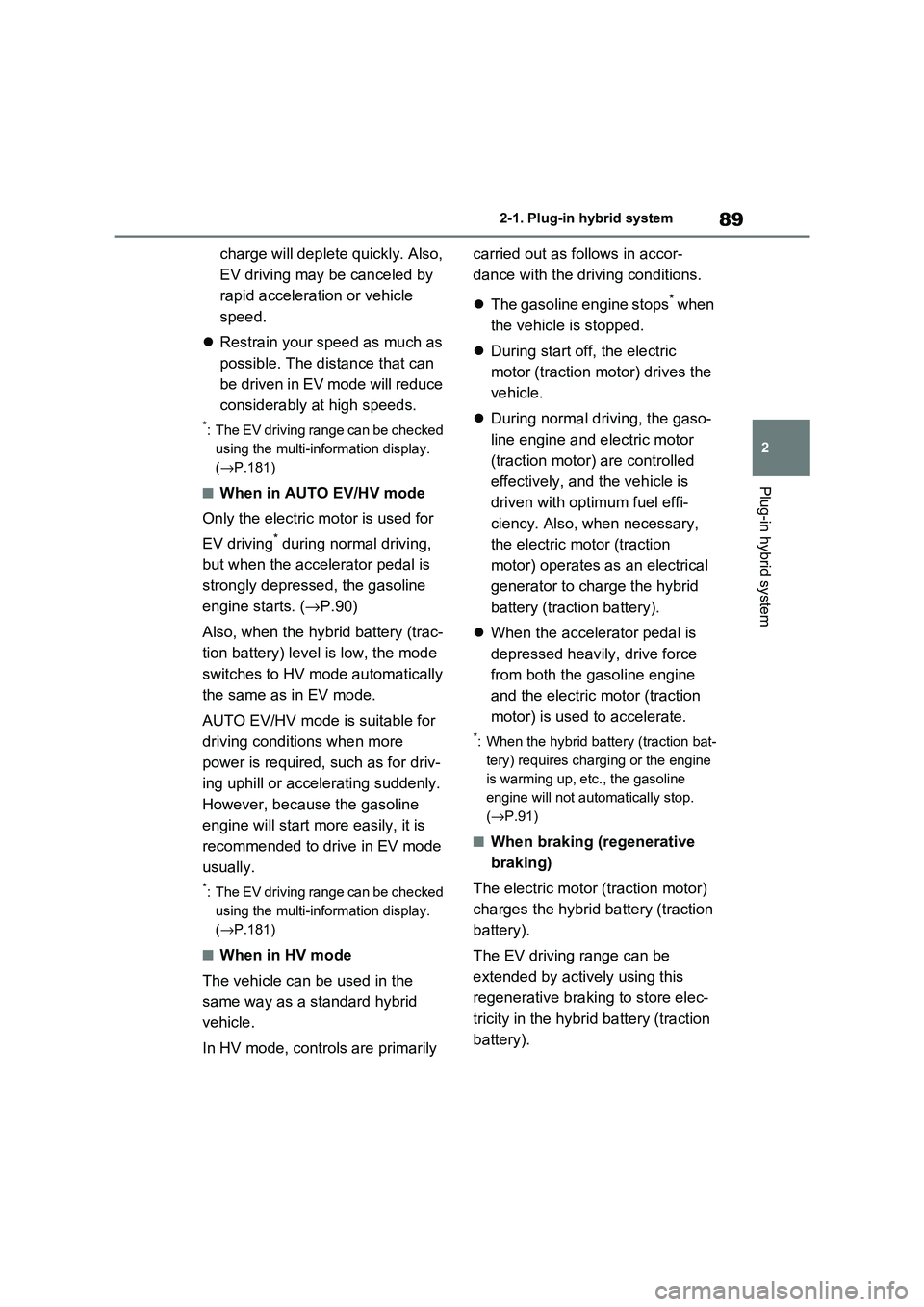
89
2
2-1. Plug-in hybrid system
Plug-in hybrid system
charge will deplete quickly. Also,
EV driving may be canceled by
rapid acceleration or vehicle
speed.
Restrain your speed as much as
possible. The distance that can
be driven in EV mode will reduce
considerably at high speeds.
*: The EV driving range can be checked
using the multi-information display.
( →P.181)
■When in AUTO EV/HV mode
Only the electric motor is used for
EV driving* during normal driving,
but when the accelerator pedal is
strongly depressed, the gasoline
engine starts. ( →P.90)
Also, when the hybrid battery (trac -
tion battery) level is low, the mode
switches to HV mode automatically
the same as in EV mode.
AUTO EV/HV mode i s suitable for
driving conditions when more
power is required, such as for driv -
ing uphill or accelerating suddenly.
However, because the gasoline
engine will start more easily, it is
recommended to drive in EV mode
usually.
*: The EV driving range can be checked
using the multi-information display.
( →P.181)
■When in HV mode
The vehicle can be used in the
same way as a standard hybrid
vehicle.
In HV mode, controls are primarily
carried out as follows in accor -
dance with the driving conditions.
The gasoline engine stops* when
the vehicle is stopped.
During start off, the electric
motor (traction motor) drives the
vehicle.
During normal driving, the gaso-
line engine and electric motor
(traction motor) are controlled
effectively, and the vehicle is
driven with optimum fuel effi -
ciency. Also, when necessary,
the electric motor (traction
motor) operates as an electrical
generator to charge the hybrid
battery (traction battery).
When the accelerator pedal is
depressed heavily, drive force
from both the gasoline engine
and the electric motor (traction
motor) is used to accelerate.
*: When the hybrid battery (traction bat -
tery) requires char ging or the engine
is warming up, etc., the gasoline
engine will not autom atically stop.
( →P.91)
■When braking (regenerative
braking)
The electric motor (traction motor)
charges the hybrid battery (traction
battery).
The EV driving range can be
extended by actively using this
regenerative braking to store elec -
tricity in the hybrid battery (traction
battery).
Page 92 of 666
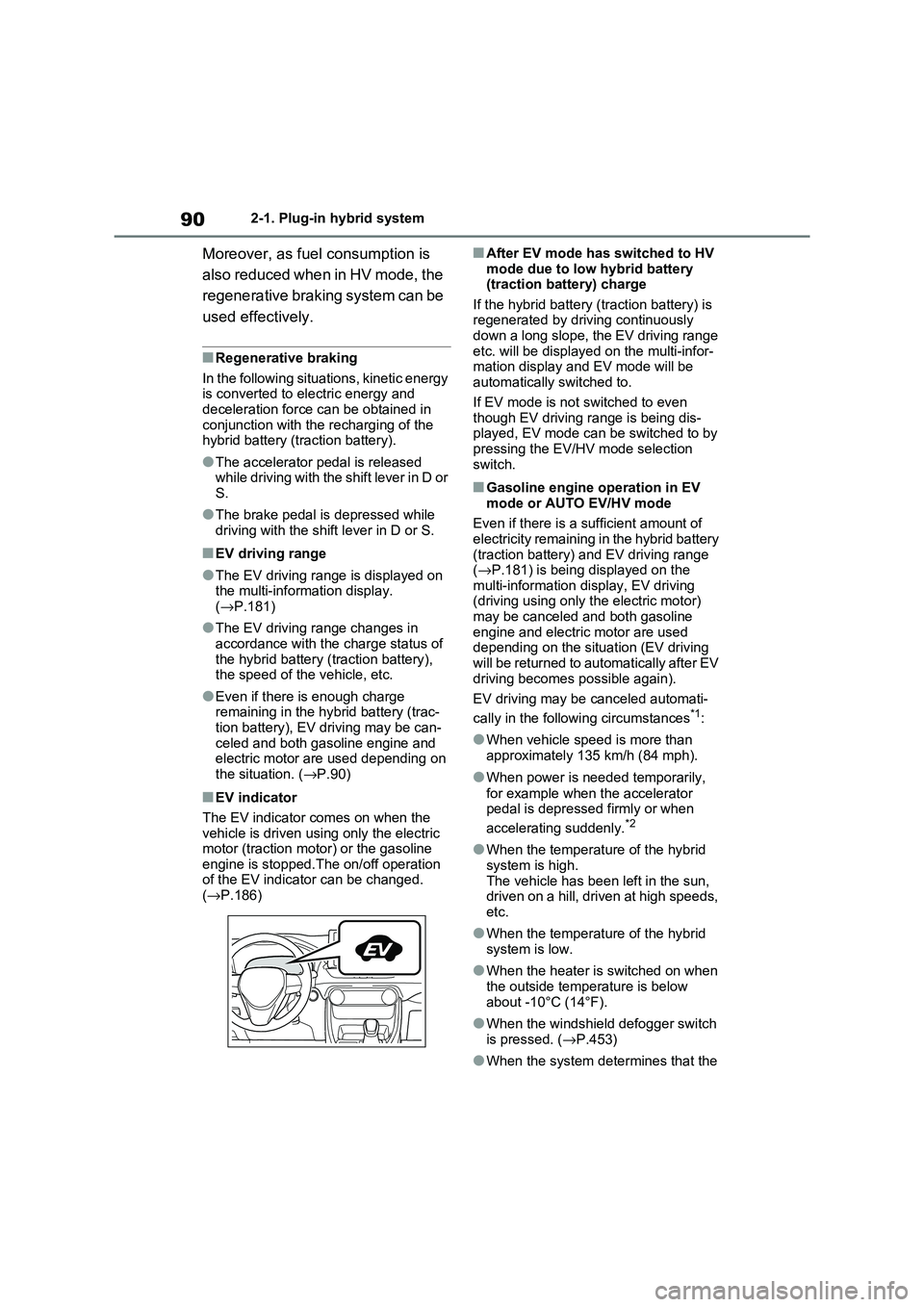
902-1. Plug-in hybrid system
Moreover, as fuel consumption is
also reduced when in HV mode, the
regenerative braking system can be
used effectively.
■Regenerative braking
In the following situations, kinetic energy is converted to electric energy and
deceleration force can be obtained in
conjunction with the recharging of the hybrid battery (traction battery).
●The accelerator pedal is released while driving with the shift lever in D or
S.
●The brake pedal is depressed while
driving with the shift lever in D or S.
■EV driving range
●The EV driving range is displayed on
the multi-information display.
( →P.181)
●The EV driving range changes in
accordance with the charge status of the hybrid battery ( traction battery),
the speed of the vehicle, etc.
●Even if there is enough charge
remaining in t he hybrid battery (trac-
tion battery), EV driving may be can- celed and both gasoline engine and
electric motor are used depending on
the situation. ( →P.90)
■EV indicator
The EV indicator comes on when the vehicle is driven usin g only the electric
motor (traction moto r) or the gasoline
engine is stopped.The on/off operation of the EV indicator can be changed.
( →P.186)
■After EV mode has switched to HV
mode due to low hybrid battery (traction battery) charge
If the hybrid battery ( traction battery) is
regenerated by driving continuously down a long slope, the EV driving range
etc. will be displaye d on the multi-infor-
mation display and EV mode will be automatically switched to.
If EV mode is not switched to even
though EV driving range is being dis - played, EV mode can be switched to by
pressing the EV/HV mode selection
switch.
■Gasoline engine operation in EV mode or AUTO EV/HV mode
Even if there is a su fficient amount of
electricity remaining in the hybrid battery (traction battery) and EV driving range
( →P.181) is being displayed on the
multi-information display, EV driving (driving using only the electric motor)
may be canceled and both gasoline
engine and electric motor are used depending on the situation (EV driving
will be returned to automatically after EV
driving becomes possible again).
EV driving may be canceled automati -
cally in the follo wing circumstances*1:
●When vehicle speed is more than
approximately 135 km/h (84 mph).
●When power is needed temporarily,
for example when the accelerator
pedal is depressed firmly or when
accelerating suddenly.*2
●When the temperatu re of the hybrid
system is high. The vehicle has been left in the sun,
driven on a hill, driven at high speeds,
etc.
●When the temperatu re of the hybrid
system is low.
●When the heater is switched on when
the outside temperature is below
about -10°C (14°F).
●When the windshield defogger switch
is pressed. ( →P.453)
●When the system determines that the
Page 93 of 666
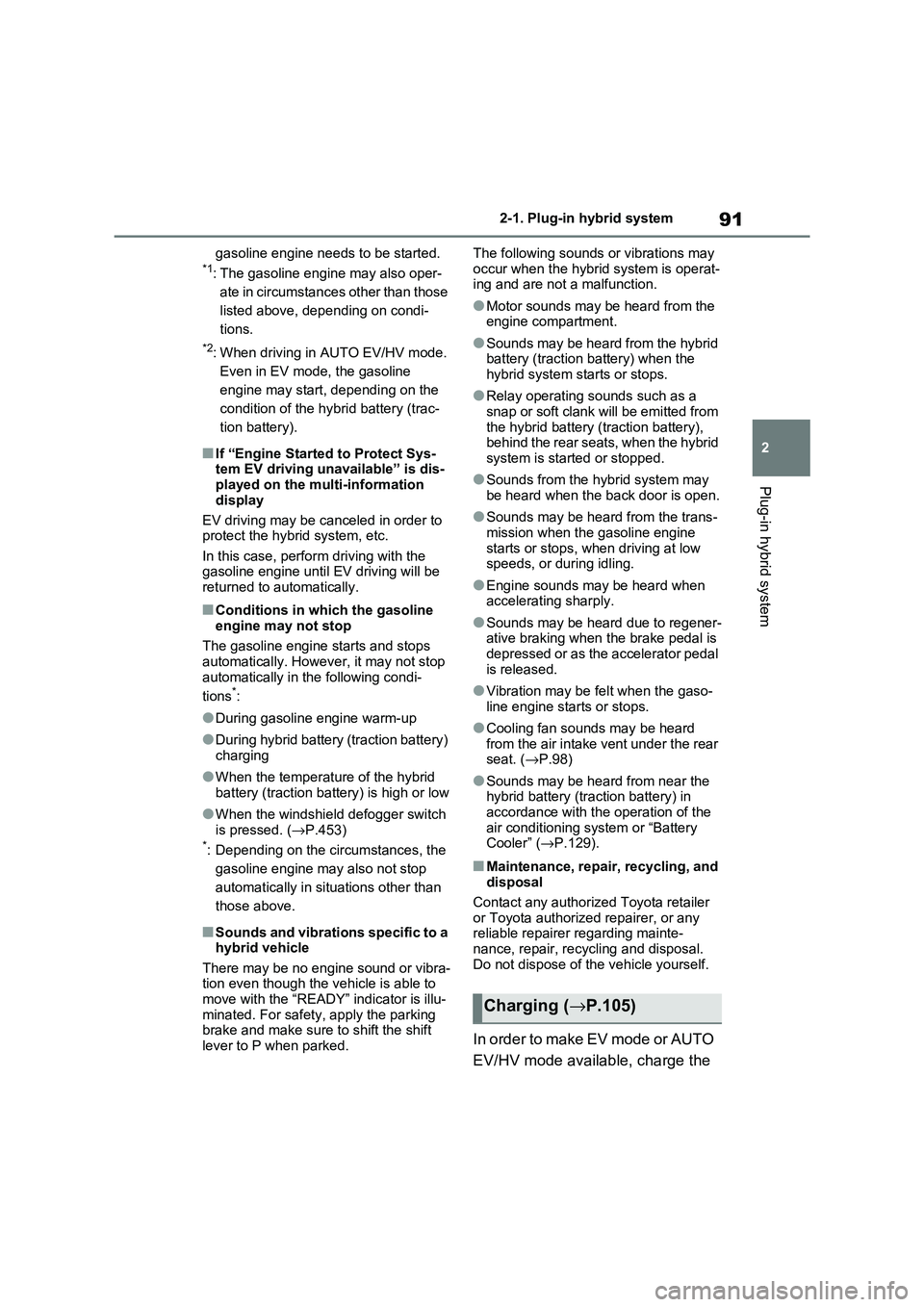
91
2
2-1. Plug-in hybrid system
Plug-in hybrid system
gasoline engine needs to be started.*1: The gasoline engine may also oper -
ate in circumstances other than those
listed above, depending on condi -
tions.
*2: When driving in AUTO EV/HV mode.
Even in EV mode, the gasoline
engine may start, depending on the
condition of the hybrid battery (trac -
tion battery).
■If “Engine Started to Protect Sys -
tem EV driving unavailable” is dis - played on the mu lti-information
display
EV driving may be canceled in order to protect the hybr id system, etc.
In this case, perform driving with the
gasoline engine until EV driving will be returned to automatically.
■Conditions in which the gasoline
engine may not stop
The gasoline engine starts and stops automatically. Howev er, it may not stop
automatically in the following condi -
tions*:
●During gasoline engine warm-up
●During hybrid battery (traction battery)
charging
●When the temperature of the hybrid
battery (traction batt ery) is high or low
●When the windshield defogger switch
is pressed. ( →P.453)*: Depending on the circumstances, the
gasoline engine may also not stop
automatically in sit uations other than
those above.
■Sounds and vibrations specific to a
hybrid vehicle
There may be no engine sound or vibra - tion even though the vehicle is able to
move with the “READY” indicator is illu-
minated. For safety, apply the parking brake and make sure to shift the shift
lever to P when parked.
The following sounds o r vibrations may
occur when the hyb rid system is operat- ing and are not a malfunction.
●Motor sounds may be heard from the engine compartment.
●Sounds may be heard from the hybrid battery (traction battery) when the
hybrid system starts or stops.
●Relay operating sounds such as a
snap or soft clank will be emitted from
the hybrid battery ( traction battery), behind the rear seats, when the hybrid
system is started or stopped.
●Sounds from the hy brid system may
be heard when the back door is open.
●Sounds may be heard from the trans -
mission when the gasoline engine
starts or stops, when driving at low speeds, or during idling.
●Engine sounds may be heard when accelerating sharply.
●Sounds may be heard due to regener - ative braking when t he brake pedal is
depressed or as the accelerator pedal
is released.
●Vibration may be f elt when the gaso-
line engine starts or stops.
●Cooling fan sounds may be heard
from the air intake vent under the rear seat. ( →P.98)
●Sounds may be heard from near the hybrid battery (traction battery) in
accordance with th e operation of the
air conditioning syst em or “Battery Cooler” ( →P.129).
■Maintenance, repair, recycling, and
disposal
Contact any authoriz ed Toyota retailer
or Toyota authorized repairer, or any reliable repairer regarding mainte -
nance, repair, recycling and disposal.
Do not dispose of the vehicle yourself.
I n o r d e r t o m a k e E V m o d e o r A U T O
EV/HV mode available, charge the
Charging ( →P.105)
Page 94 of 666
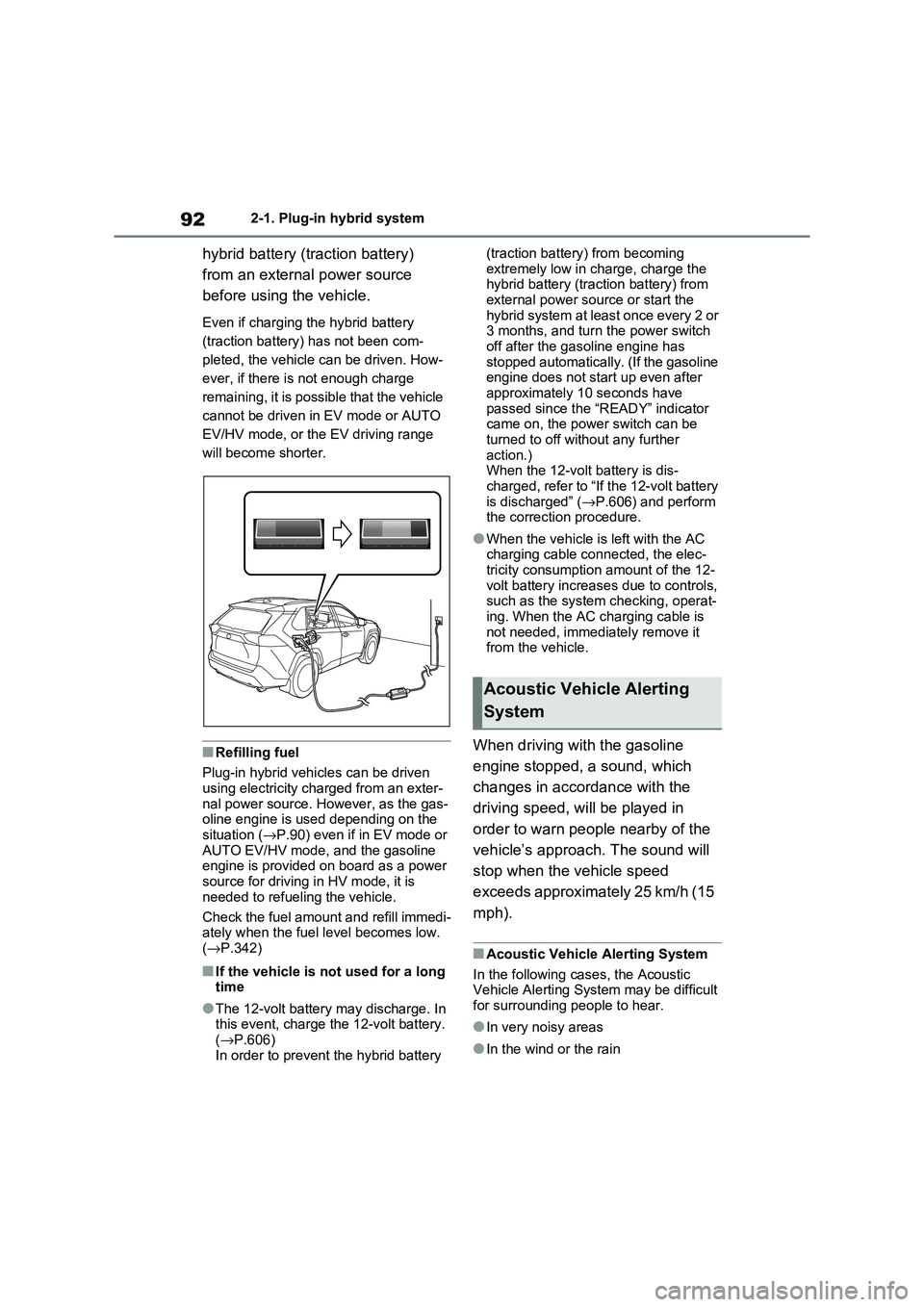
922-1. Plug-in hybrid system
hybrid battery (traction battery)
from an external power source
before using the vehicle.
Even if charging t he hybrid battery
(traction battery) has not been com-
pleted, the vehicle can be driven. How -
ever, if there is not enough charge
remaining, it is possible that the vehicle
cannot be driven in EV mode or AUTO
EV/HV mode, or the EV driving range
will become shorter.
■Refilling fuel
Plug-in hybrid vehicl es can be driven
using electricity charged from an exter -
nal power source. However, as the gas - oline engine is used depending on the
situation ( →P.90) even if in EV mode or
AUTO EV/HV mode, and the gasoline engine is provided on board as a power
source for driving in HV mode, it is
needed to refueling the vehicle.
Check the fuel amount and refill immedi -
ately when the fuel level becomes low.
( →P.342)
■If the vehicle is not used for a long
time
●The 12-volt battery may discharge. In
this event, charge t he 12-volt battery. ( →P.606)
In order to prevent t he hybrid battery
(traction battery) from becoming
extremely low in c harge, charge the hybrid battery (trac tion battery) from
external power source or start the
hybrid system at least once every 2 or 3 months, and turn the power switch
off after the gasoline engine has
stopped automatically. (If the gasoline engine does not sta rt up even after
approximately 10 seconds have
passed since the “READY” indicator came on, the power switch can be
turned to off without any further
action.) When the 12-volt battery is dis -
charged, refer to “If the 12-volt battery
is discharged” ( →P.606) and perform the correction procedure.
●When the vehicle is left with the AC charging cable co nnected, the elec-
tricity consumption amount of the 12-
volt battery increas es due to controls, such as the system checking, operat-
ing. When the AC charging cable is
not needed, immediately remove it from the vehicle.
When driving with the gasoline
engine stopped, a sound, which
changes in accord ance with the
driving speed, wil l be played in
order to warn people nearby of the
vehicle’s approach. The sound will
stop when the vehicle speed
exceeds approximately 25 km/h (15
mph).
■Acoustic Vehicle Alerting System
In the following cases, the Acoustic
Vehicle Alerting System may be difficult for surrounding people to hear.
●In very noisy areas
●In the wind or the rain
Acoustic Vehicle Alerting
System
Page 95 of 666
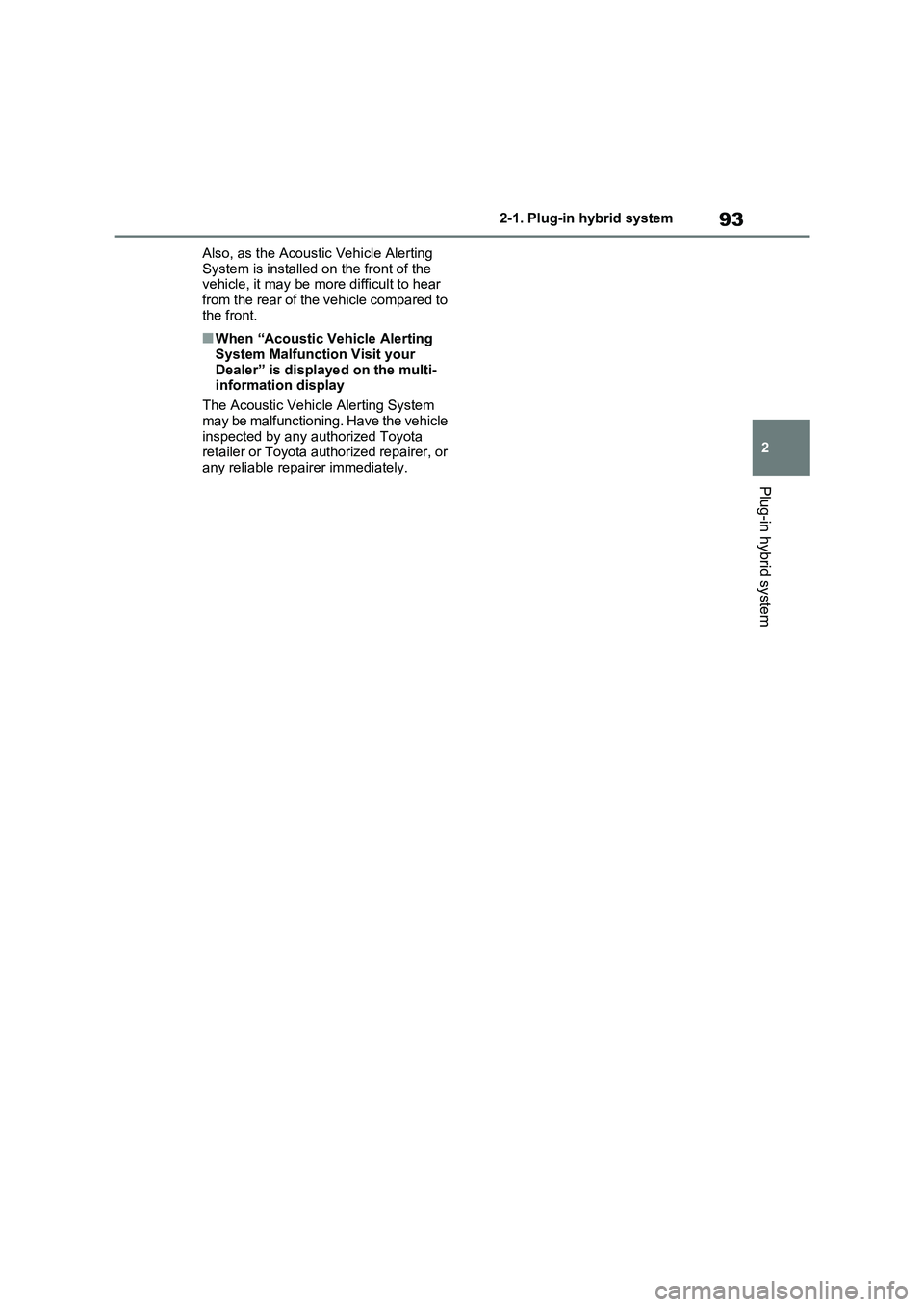
93
2
2-1. Plug-in hybrid system
Plug-in hybrid system
Also, as the Acoustic Vehicle Alerting
System is installed on the front of the vehicle, it may be more difficult to hear
from the rear of the vehicle compared to
the front.
■When “Acoustic Vehicle Alerting System Malfunction Visit your
Dealer” is displaye d on the multi-
information display
The Acoustic Vehicle Alerting System
may be malfunctioning. Have the vehicle
inspected by any authorized Toyota retailer or Toyota authorized repairer, or
any reliable repairer immediately.
Page 96 of 666
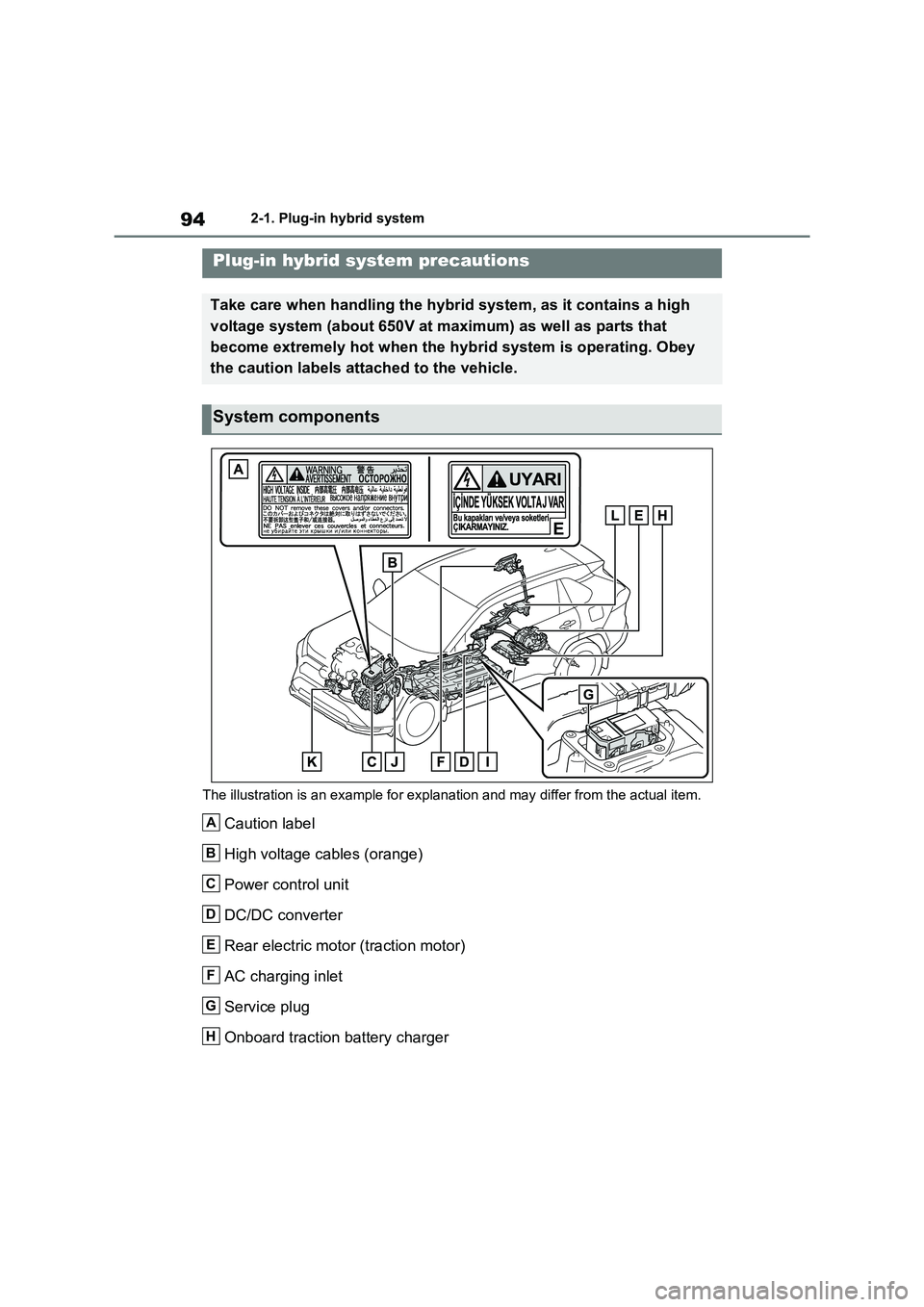
942-1. Plug-in hybrid system
The illustration is an example fo r explanation and may differ from the actual item.
Caution label
High voltage cables (orange)
Power control unit
DC/DC converter
Rear electric motor (traction motor)
AC charging inlet
Service plug
Onboard traction battery charger
Plug-in hybrid system precautions
Take care when handling the hybr id system, as it contains a high
voltage system (about 650V at maximum) as well as parts that
become extremely hot when the hy brid system is operating. Obey
the caution labels attached to the vehicle.
System components
A
B
C
D
E
F
G
H
Page 97 of 666
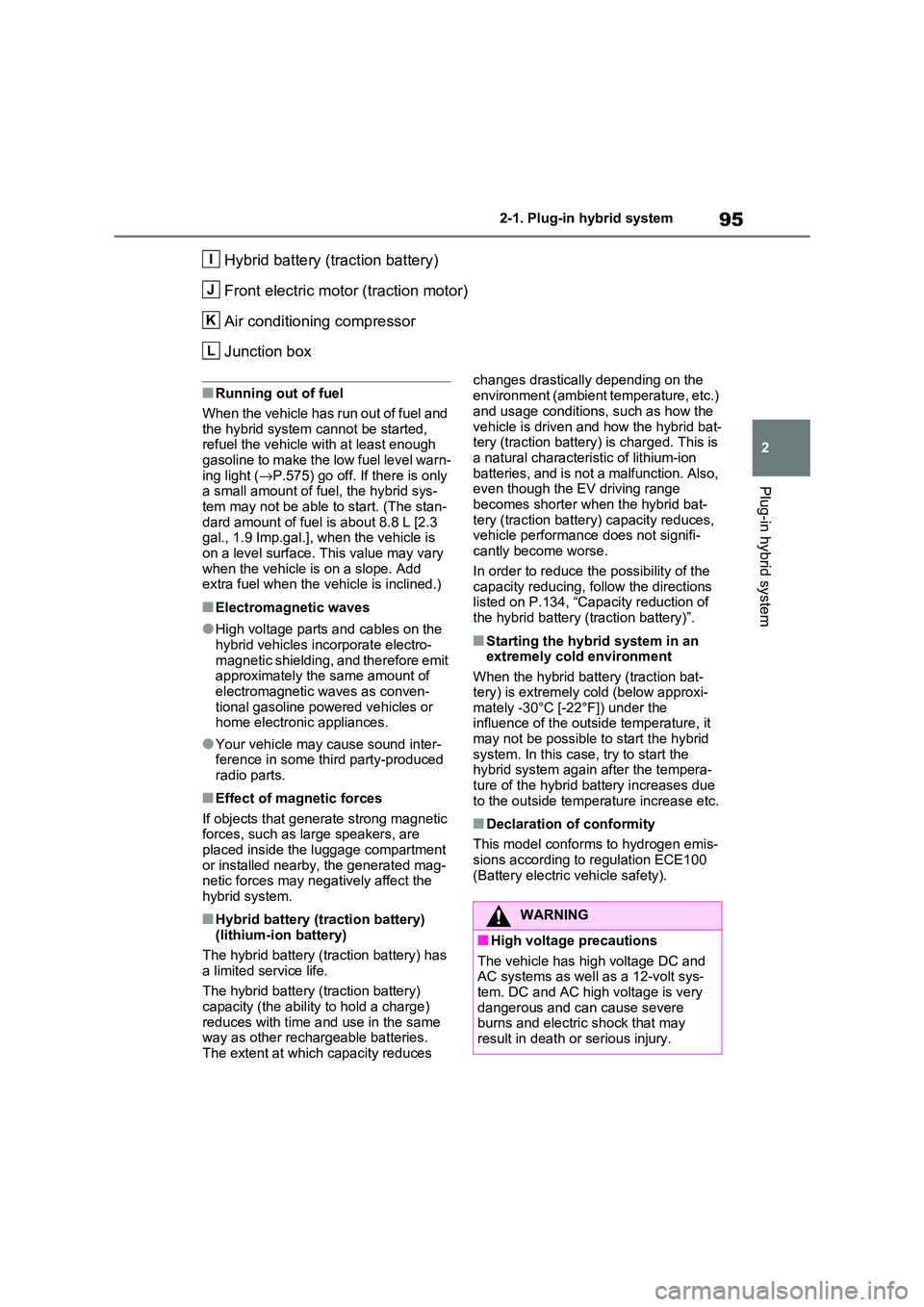
95
2
2-1. Plug-in hybrid system
Plug-in hybrid system
Hybrid battery (traction battery)
Front electric motor (traction motor)
Air conditioning compressor
Junction box
■Running out of fuel
When the vehicle has run out of fuel and
the hybrid system c annot be started, refuel the vehicle with at least enough
gasoline to make the low fuel level warn -
ing light ( →P.575) go off. If there is only a small amount of fuel, the hybrid sys -
tem may not be able to start. (The stan -
dard amount of fuel is about 8.8 L [2.3 gal., 1.9 Imp.gal.], w hen the vehicle is
on a level surface. This value may vary
when the vehicle is on a slope. Add extra fuel when the vehicle is inclined.)
■Electromagnetic waves
●High voltage parts and cables on the hybrid vehicles incorporate electro -
magnetic shielding, and therefore emit
approximately the same amount of electromagnetic waves as conven -
tional gasoline powered vehicles or
home electronic appliances.
●Your vehicle may cause sound inter -
ference in some third party-produced radio parts.
■Effect of magnetic forces
If objects that generate strong magnetic
forces, such as large speakers, are placed inside the luggage compartment
or installed nearby, the generated mag -
netic forces may negatively affect the hybrid system.
■Hybrid battery (tr action battery)
(lithium-ion battery)
The hybrid battery (traction battery) has a limited service life.
The hybrid battery (traction battery)
capacity (the ability to hold a charge) reduces with time a nd use in the same
way as other rechargeable batteries.
The extent at which capacity reduces
changes drastically depending on the
environment (ambient temperature, etc.)
and usage conditions, such as how the
vehicle is driven and how the hybrid bat - tery (traction battery) is charged. This is
a natural characteristic of lithium-ion
batteries, and is not a malfunction. Also, even though the EV driving range
becomes shorter when the hybrid bat -
tery (traction batter y) capacity reduces, vehicle performance does not signifi -
cantly become worse.
In order to reduce th e possibility of the capacity reducing, follow the directions
listed on P.134, “Capacity reduction of
the hybrid battery ( traction battery)”.
■Starting the hybrid system in an extremely cold environment
When the hybrid battery (traction bat -
tery) is extremely c old (below approxi- mately -30°C [-22°F]) under the
influence of the outsi de temperature, it
may not be possible to start the hybrid system. In this case , try to start the
hybrid system again after the tempera -
ture of the hy brid battery increases due to the outside temperature increase etc.
■Declaration of conformity
This model conform s to hydrogen emis-
sions according to regulation ECE100 (Battery electric vehicle safety).
I
J
K
L
WARNING
■High voltage precautions
The vehicle has high voltage DC and
AC systems as well as a 12-volt sys- tem. DC and AC high voltage is very
dangerous and can cause severe
burns and electric shock that may result in death or serious injury.
Page 98 of 666
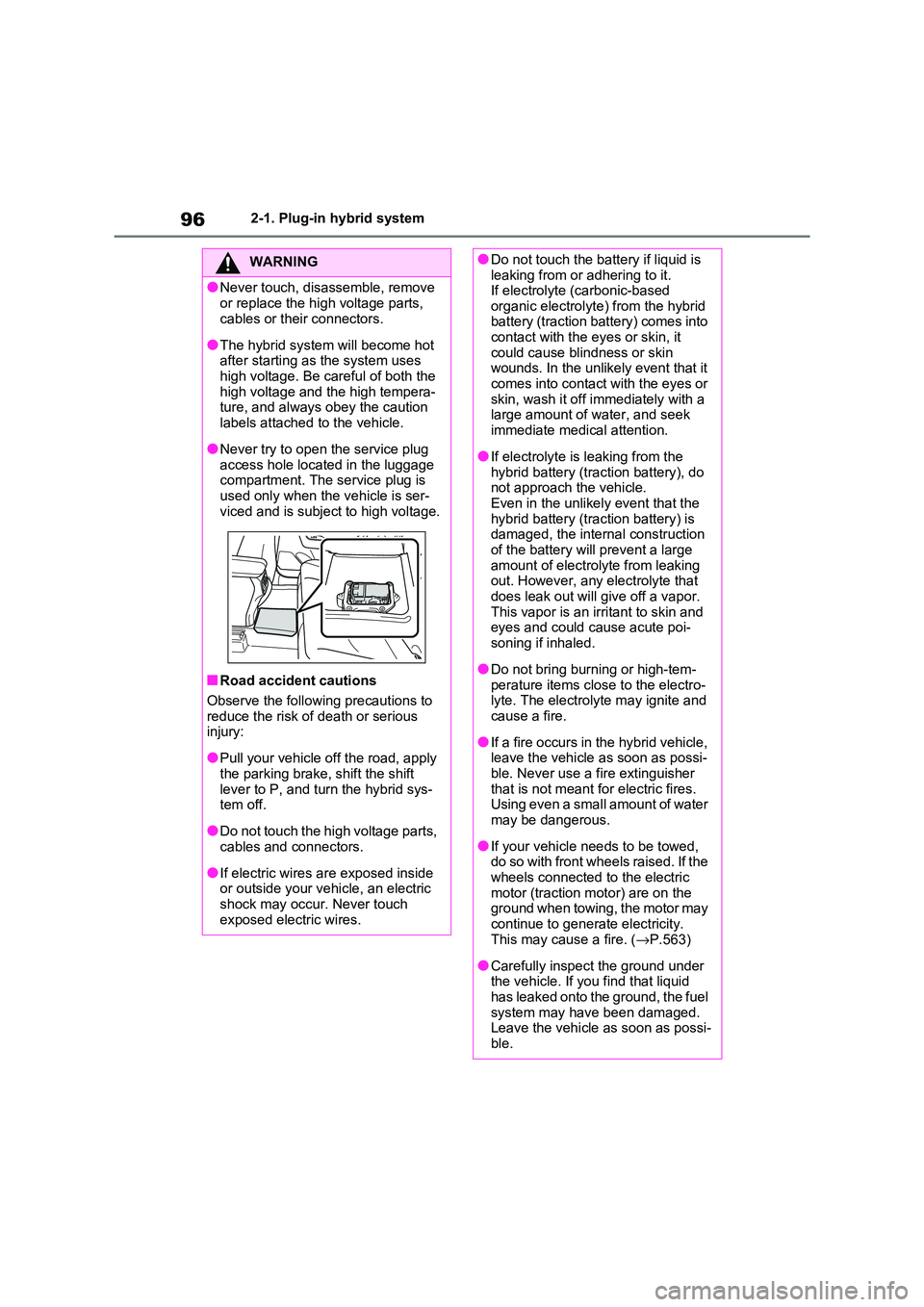
962-1. Plug-in hybrid system
WARNING
●Never touch, disassemble, remove
or replace the high voltage parts,
cables or their connectors.
●The hybrid system will become hot
after starting a s the system uses high voltage. Be careful of both the
high voltage and the high tempera -
ture, and always obe y the caution
labels attached to the vehicle.
●Never try to open the service plug
access hole located in the luggage compartment. The service plug is
used only when the vehicle is ser-
viced and is subject to high voltage.
■Road accident cautions
Observe the following precautions to reduce the risk of d eath or serious
injury:
●Pull your vehicle off the road, apply
the parking brake, shift the shift
lever to P, and tu rn the hybrid sys- tem off.
●Do not touch the high voltage parts, cables and connectors.
●If electric wires are exposed inside or outside your vehi cle, an electric
shock may occur. Never touch
exposed electric wires.
●Do not touch the battery if liquid is leaking from or adhering to it.
If electrolyte ( carbonic-based
organic electrolyte) from the hybrid battery (traction battery) comes into
contact with the eyes or skin, it
could cause blindness or skin wounds. In the unlik ely event that it
comes into contact with the eyes or
skin, wash it off immediately with a large amount of w ater, and seek
immediate medical attention.
●If electrolyte is leaking from the
hybrid battery (traction battery), do
not approach the vehicle. Even in the unlikely event that the
hybrid battery (traction battery) is
damaged, the internal construction of the battery wil l prevent a large
amount of electrolyte from leaking
out. However, any electrolyte that does leak out will g ive off a vapor.
This vapor is an irritant to skin and
eyes and could c ause acute poi- soning if inhaled.
●Do not bring burning or high-tem - perature items close to the electro -
lyte. The electrolyte may ignite and
cause a fire.
●If a fire occurs in the hybrid vehicle,
leave the vehicle as soon as possi - ble. Never use a f ire extinguisher
that is not meant fo r electric fires.
Using even a small amount of water may be dangerous.
●If your vehicle nee ds to be towed, do so with front wheels raised. If the
wheels connected to the electric
motor (traction motor) are on the ground when towing, the motor may
continue to generate electricity.
This may cause a fire. ( →P.563)
●Carefully inspect the ground under
the vehicle. If you find that liquid
has leaked onto the ground, the fuel system may have been damaged.
Leave the vehicle as soon as possi -
ble.
Page 99 of 666
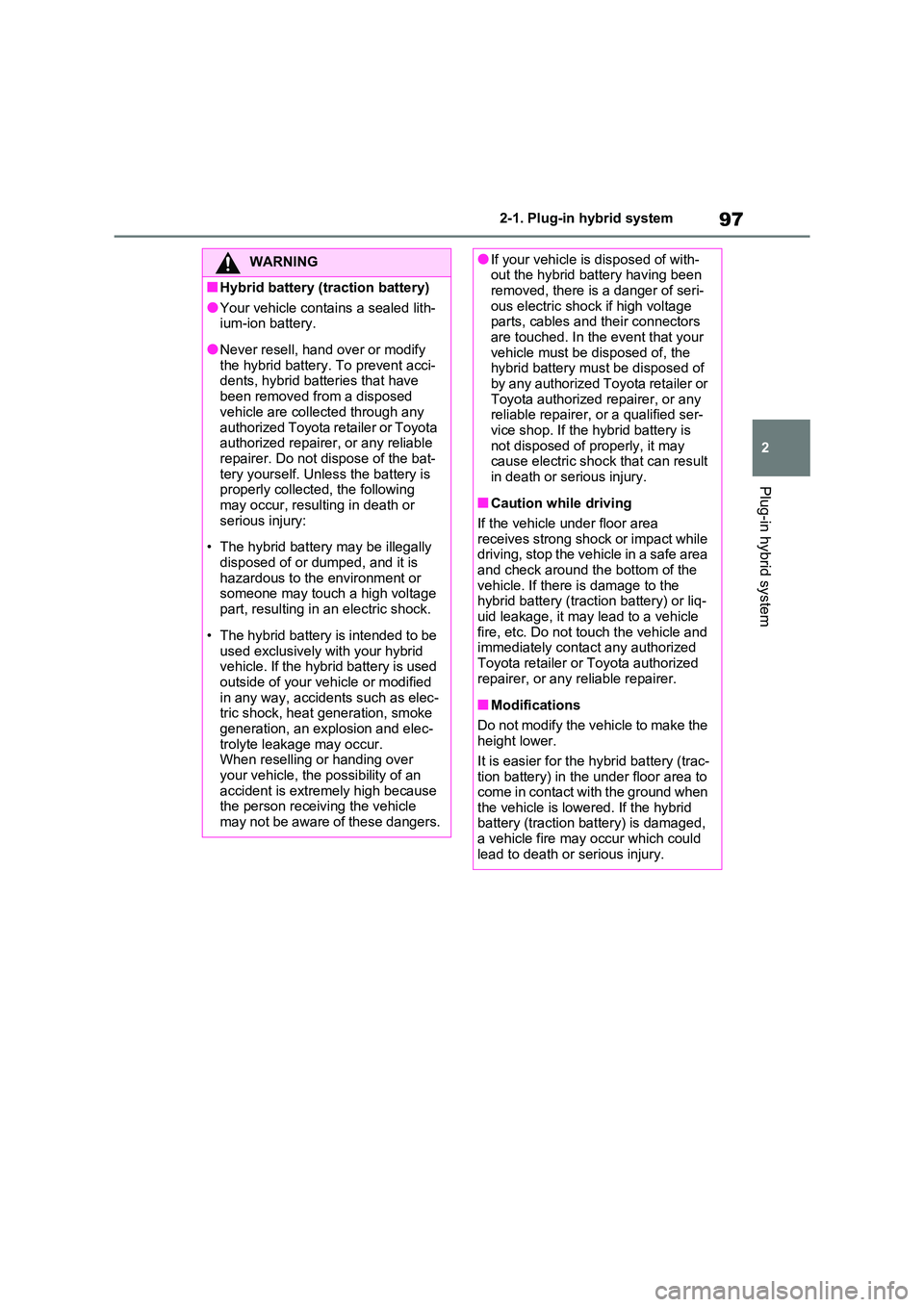
97
2
2-1. Plug-in hybrid system
Plug-in hybrid system
WARNING
■Hybrid battery ( traction battery)
●Your vehicle contains a sealed lith-
ium-ion battery.
●Never resell, hand over or modify
the hybrid battery . To prevent acci- dents, hybrid batteries that have
been removed from a disposed
vehicle are collected through any
authorized Toyota retailer or Toyota authorized repairer, or any reliable
repairer. Do not dispose of the bat -
tery yourself. Unless the battery is properly collected, the following
may occur, resulting in death or
serious injury:
• The hybrid battery may be illegally
disposed of or dumped, and it is hazardous to the environment or
someone may touch a high voltage
part, resulting in an electric shock.
• The hybrid battery is intended to be
used exclusively with your hybrid vehicle. If the hybrid battery is used
outside of your vehicle or modified
in any way, accidents such as elec - tric shock, heat generation, smoke
generation, an ex plosion and elec-
trolyte leakage may occur. When reselling or handing over
your vehicle, the possibility of an
accident is extremely high because the person receiving the vehicle
may not be aware of these dangers.
●If your vehicle is disposed of with- out the hybrid bat tery having been
removed, there is a danger of seri -
ous electric shock if high voltage parts, cables and their connectors
are touched. In t he event that your
vehicle must be disposed of, the hybrid battery mus t be disposed of
by any authorized Toyota retailer or
Toyota authorized repairer, or any reliable repairer, or a qualified ser -
vice shop. If the hybrid battery is
not disposed of properly, it may cause electric shock that can result
in death or serious injury.
■Caution while driving
If the vehicle under floor area
receives strong shock or impact while driving, stop the vehicle in a safe area
and check around th e bottom of the
vehicle. If there is damage to the hybrid battery (traction battery) or liq -
uid leakage, it may lead to a vehicle
fire, etc. Do not touch the vehicle and immediately contac t any authorized
Toyota retailer or Toyota authorized
repairer, or any reliable repairer.
■Modifications
Do not modify the v ehicle to make the height lower.
It is easier for the hybrid battery (trac -
tion battery) in the under floor area to come in contact with the ground when
the vehicle is lowered. If the hybrid
battery (traction bat tery) is damaged, a vehicle fire may occur which could
lead to death or serious injury.
Page 100 of 666
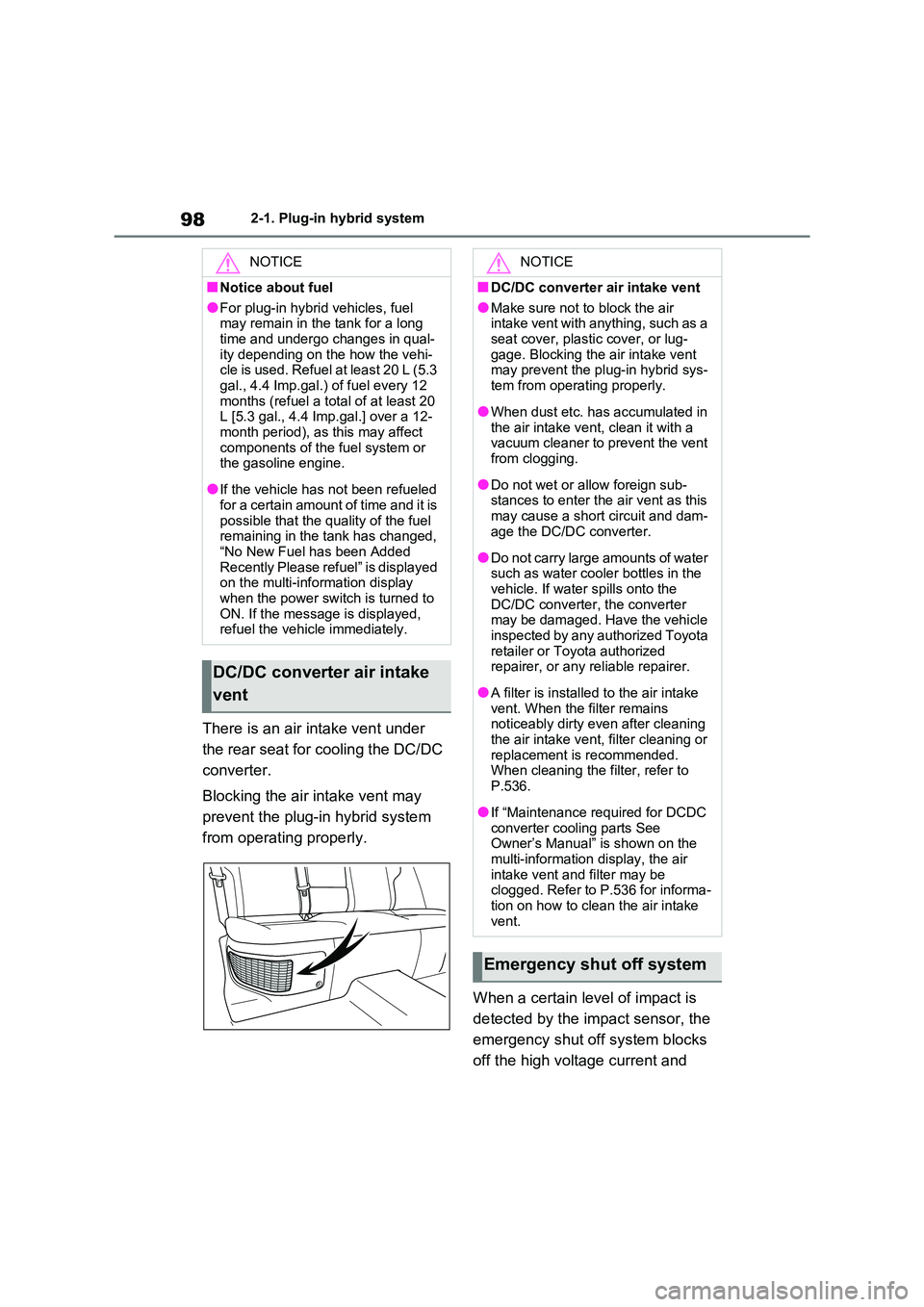
982-1. Plug-in hybrid system
There is an air intake vent under
the rear seat for cooling the DC/DC
converter.
Blocking the air intake vent may
prevent the plug-in hybrid system
from operating properly.
When a certain level of impact is
detected by the im pact sensor, the
emergency shut off system blocks
off the high voltage current and
NOTICE
■Notice about fuel
●For plug-in hybrid vehicles, fuel
may remain in the tank for a long time and undergo changes in qual -
ity depending on the how the vehi -
cle is used. Refuel at least 20 L (5.3 gal., 4.4 Imp.gal. ) of fuel every 12
months (refuel a tot al of at least 20
L [5.3 gal., 4.4 Imp.gal.] over a 12-
month period), as this may affect components of the fuel system or
the gasoline engine.
●If the vehicle has not been refueled
for a certain amount of time and it is
possible that the quality of the fuel remaining in the tank has changed,
“No New Fuel has been Added
Recently Please refuel” is displayed on the multi-information display
when the power switch is turned to
ON. If the message is displayed, refuel the vehicle immediately.
DC/DC converter air intake
vent
NOTICE
■DC/DC converter air intake vent
●Make sure not to block the air
intake vent with anything, such as a seat cover, plastic cover, or lug -
gage. Blocking the air intake vent
may prevent the plug-in hybrid sys - tem from operating properly.
●When dust etc. has accumulated in
the air intake ven t, clean it with a vacuum cleaner to prevent the vent
from clogging.
●Do not wet or a llow foreign sub-
stances to enter the air vent as this
may cause a shor t circuit and dam- age the DC/DC converter.
●Do not carry large amounts of water such as water cooler bottles in the
vehicle. If water spills onto the
DC/DC converter, the converter may be damaged. Have the vehicle
inspected by any authorized Toyota
retailer or Toyota authorized repairer, or any reliable repairer.
●A filter is installed to the air intake vent. When the filter remains
noticeably dirty even after cleaning
the air intake vent, filter cleaning or replacement is recommended.
When cleaning the filter, refer to
P.536.
●If “Maintenance required for DCDC
converter cooling parts See Owner’s Manual” is shown on the
multi-information display, the air
intake vent and filter may be clogged. Refer to P.536 for informa -
tion on how to clean the air intake
vent.
Emergency shut off system